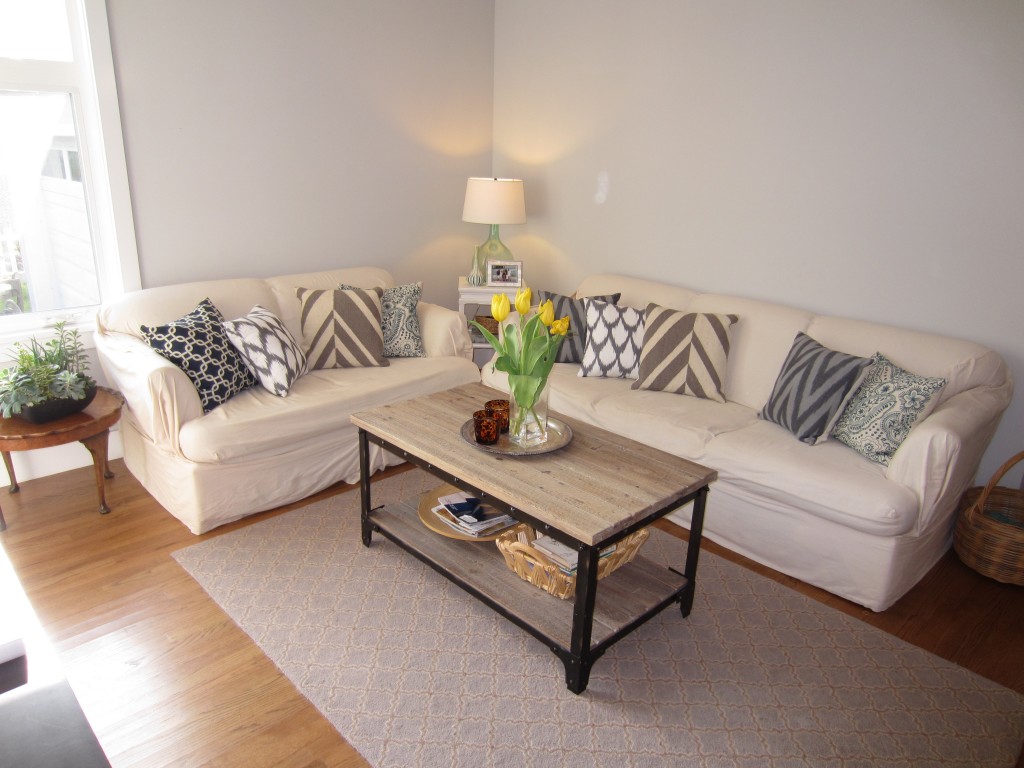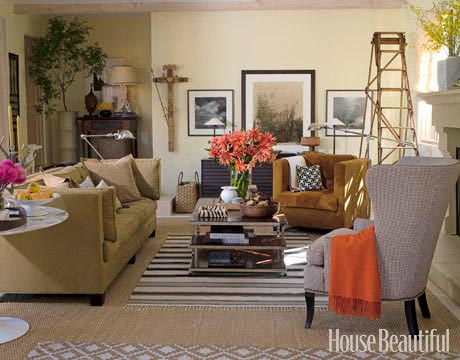The other day, a friend asked for help picking a sofa for her “formal” (i.e. not the family room with the TV, but certainly not formal in the traditional sense!) living room. She’s been living with a couple of slipcovered numbers for years now and has finally decided to take the plunge and get a new one…and I mean take the plunge. Buying a new sofa is seriously intimidating! One, it’s generally a pretty decent financial investment so you want to make sure you don’t make a mistake and two, there are so many freaking choices, where do you even start?!
Here’s a picture of her living room right now–a slipcovered sofa and loveseat:

We started our search by talking about a few guidelines for buying a sofa:
1. Determine size you need and want–and yes, while in design rules are made to be broken, it’s often easiest to just follow the rule: big room, big sofa; small room, smaller sofa. Remember, scale is just as important as length–depth of cushions, roll of arm, height of back, etc. all help determine size. A tailored sofa will automatically feel smaller and an overstuffed sofa will seem bigger. I always like measuring out the area with newspaper–cut out the paper in the width and depth of the sofa you like and see how it feels in the room. That way you can consider space for lamps, side tables, coffee table, etc.
2. Placement also impacts size. In this room, the logical place for a sofa is on the large wall on the right. A general rule is to that the optimal length of the sofa is 2/3 to 3/4 the length of the wall.
3. The next consideration is how you’ll be using the sofa–is it for a more formal room? For TV lounging? Will pets be using it (much to my chagrine, my dog spends all day lounging on my living room couch so most of the time it’s covered with an ugly blanket!) These things will determine both comfort (shape) and finish you choose. In this case, we’ll go for a casual, durable fabric. Also, I always recommend doing a neutral solid fabric–while prints are amazing and I wish I had the guts, for those of us who only buy a new sofa once every ten years (or more!), save the pattern for accent cushions and accessories.
4. Remember, what’s inside really does count because it determines how well your sofa will stand up to the “elements”–aka kids, dogs, my butt watching the Real Housewives of New York (I mean CNN!). Here’s a link to a great article on the ins and outs of furniture quality. They explain it way better than I would. [As a side story, I once went couch shopping and told the salesperson that I really didn’t want what my husband had in his last sofa cushions–sanabear. The guy looked at me like I was insane…and he was right. Sanabear doesn’t exist…when I told my husband about this exchange, he burst into laughter and said he’d referred to the crappy white cushion stuffing as “that low quality Santa Beard!” With his mumbling, I thought “sanabear” was an industry term for the cheap fluffy white stuffing…I know, I know…]
Finally, love it! There are so many choices out there, that you really don’t have to settle.
Here are a few suggestions I pulled for the space above–generally clean, classic lines with a transitional feel; casual and family-friendly, but a little “dressier.” These are the stock colors, but each is available in a lot of different fabrics.
Click on the small images to get more info–store and price. All of these are available online or from a well-known store to make it easy.
In terms of other furniture in the room, I would do just one sofa–the wall with the window on the left isn’t large enough for another big piece of furniture and with the size of the room, I would recommend chairs for flexibility.
A couple of random last thoughts that I know people ask about all the time as it relates to sofas…
• Doing a side table? A good guideline is that it should be approximately the same height as the arm of your sofa or chair–this makes it much more functional for placing a drink, lighting from a lamp, etc.
• Deciding on a coffee table? It’s most comfortable for walking and for guests if you allow around 18″ between the table and sofa edge. In terms of height, they’re all over the place, but a general “rule” is to keep the table height and seat height within 4 inches of each other.
This picture brings both of those ideas to life–the round table next to the sofa is high enough to balance the high sofa arm and the coffee table is about the same height as the seat of the sofa.











